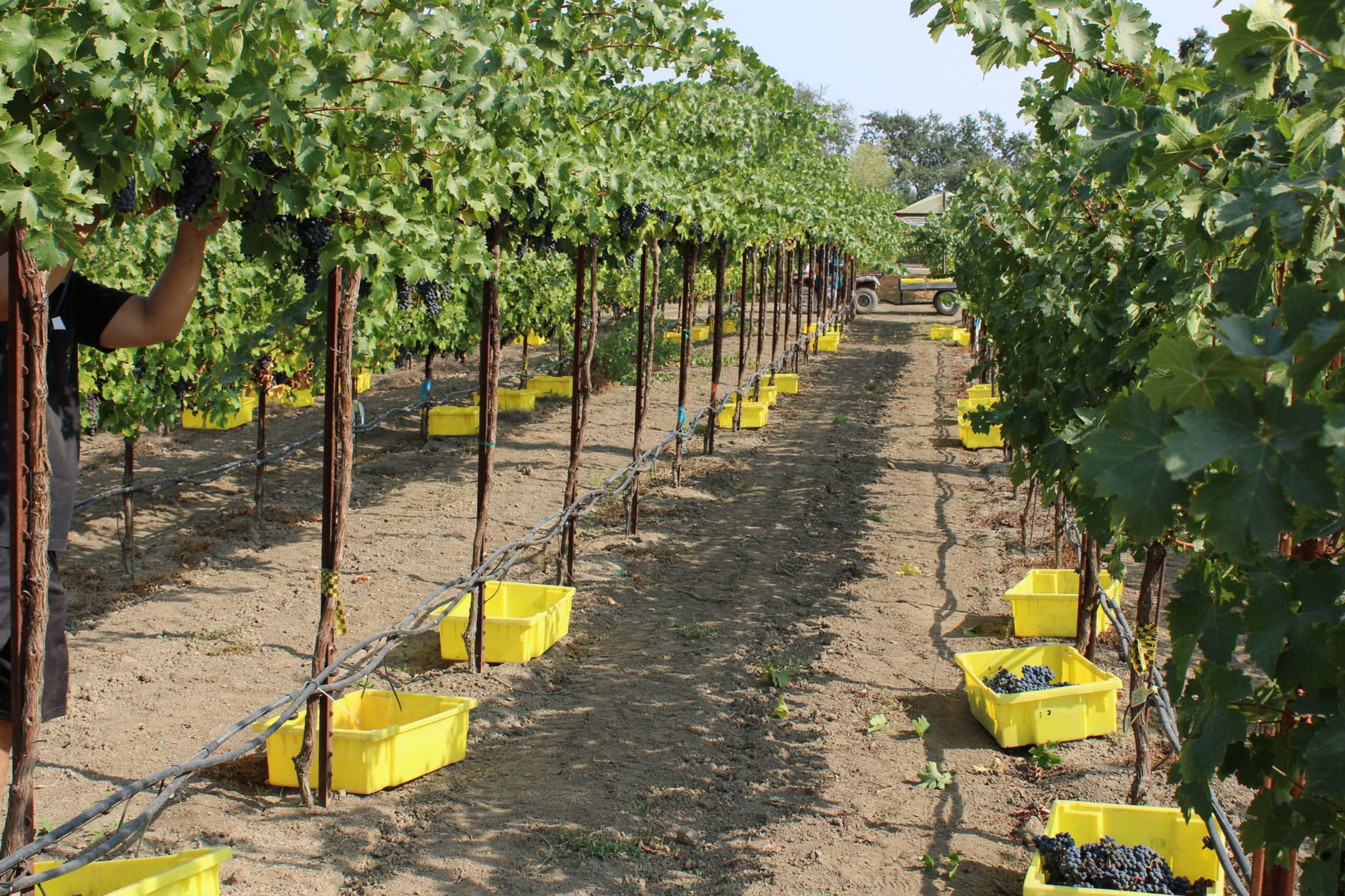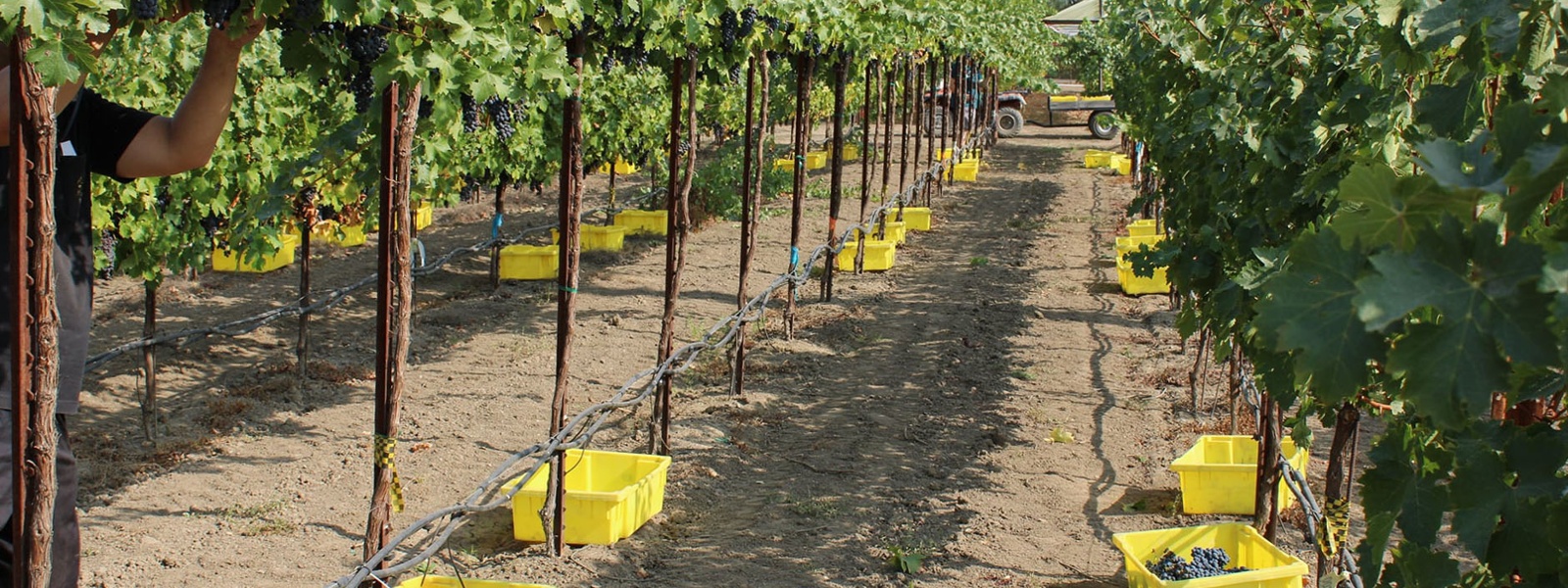Winegrape growers turn to higher trellises to beat heat


Trials at a University of California, Davis, experimental vineyard in Oakville found that using higher trellis systems offered better protection for winegrapes in extreme heat, while maintaining yield and quality.
By Caleb Hampton
With its warm summers and mild winters, California’s North Coast produces some of the world’s best winegrapes. But as the region gets hotter, growers are navigating more obstacles to bring their grapes to maturity without losing their yield or quality.
Cabernet sauvignon, Napa and Sonoma’s signature variety, needs sunlight, but excessive heat can dry out the fruit, costing growers thousands of pounds in weight per acre. It can also make the grapes too sugary. During fermentation, sugar turns into alcohol, and too much alcohol content masks the layered aromas that distinguish quality wines.
“It was definitely a challenge,” said Napa County winegrape grower Peter Nissen, speaking about August and September heat waves that caused some growers to get their grapes rejected by wineries. “In all the years I’ve been farming, it was probably the worst heat event,” said Nissen, president of the Napa County Farm Bureau.
Growers in Napa and Sonoma have tried various methods to mitigate the effects of heat on their grapes. Several years ago, a handful of Sonoma County farmers started growing cabernet grapes on high-wire trellises, a system more often seen in the Central Valley that shades the grape clusters with vine leaves.
The technique also allows growers to cut labor costs due to the trellises’ compatibility with machine pruning and other mechanized maintenance.
At the time, the decision to try the system was “purely economics,” said Duff Bevill, who owns Bevill Vineyard Management and has farmed winegrapes in Sonoma County for over four decades.
Bevill manages roughly 1,300 acres of vineyards, including 100 acres of cabernet on high-wire trellises, the largest block in that style he knows of in the North Coast. After employing the trellises, he said, he began noticing “dramatically less sun damage” to his grapes, particularly during intense heat waves.
Now, researchers at the University of California, Davis, and California State University, Fresno, have found similar results in a study, published last month in the journal Frontiers in Plant Science, that could influence future winegrape cultivation.
Over several years, they compared the quality and yield of cabernet grapes grown on six different trellis systems at the UC Davis Oakville Research Station in Napa. The researchers found that vertical shoot position (VSP) trellises, favored for decades by North Coast growers, expose the grapes to too much direct sunlight and provide little protection from solar radiation, especially when the ground reflects heat up into the clusters.
“We constantly see sunburn issues,” said Runze “Cliff” Yu, assistant professor of viticulture and enology at Fresno State and co-author of the study.
The researchers recommended cabernet growers in the North Coast switch to single high-wire trellises, which produced the study’s best results.
“The fruit maturity is decent, and the berry quality, in terms of the color and other flavonoids or compounds, are the most accumulating in this system,” said Yu, referring to chemical components that are key to making high-end wines. “The single high wire can really perform in this climate.”
Other growers have noticed similar results. Bret Munselle, general manager of Munselle Vineyards in Sonoma County, has two smaller blocks of cabernet on single high wires, which he planted several years ago to save on labor costs.
“We didn’t see hardly any sun damage on those vines,” Munselle said. With the high-wire trellises, he added, “you get dappled light throughout the canopy, but you rarely have direct sunlight for extended periods on any one grape or bunch of grapes.”
While some growers in Napa and Sonoma have moved away from VSP trellises in recent years, few have opted for the single high-wire system. “Locally, there’s not too many doing it,” Bevill said.
Retraining vines into high-wire trellises can be done in 18 months without replanting, the researchers said, a relatively short timeframe for growers with decades-old grapevines.
Yu, the Fresno State researcher, said he believes the benefits of the high-wire trellis for North Coast growers are so compelling that growers in the region will ultimately move toward that system or others that are similar. “They have to be adaptable in order to be able to keep farming,” he said. “Changing the trellis is the simple way to solve the problem.”
For growers, setting up the trellises is only one piece of the puzzle. About half of Sonoma County’s winegrapes are grown by winemaking estates, with the other half farmed by growers who sell their grapes to wineries.
“Where we are right now is convincing our wineries that it’ll work for them,” said Munselle. In a high-dollar industry that puts a premium on locale and tradition, North Coast growers have encountered reluctance by some wineries to buy grapes grown in a style most associate with less prestigious wine regions.
“There have been large wineries that simply didn’t believe that it would be good quality,” Bevill said. “But in blind tasting, it proved to be equal to or better than the other systems.”
The growers likened the situation to the shift a couple decades ago from hand-picking to mechanical harvesting, which wineries initially shunned but eventually welcomed.
“When we get into different trellis systems, it becomes even more of a political issue, with different wineries accepting or not accepting new ideas,” Bevill said. “That’s the biggest challenge. It’s not the grower—it’s the grower thinking, ‘Who am I going to sell this to?’”
For now, Bevill and Munselle are forging ahead. Bevill has already expanded his high-wire trellis acreage and plans to use it for some new plantings.
Next year, Munselle will plant 40 more acres of cabernet on high-wire trellises, his biggest block yet. “I have pretty high hopes,” he said.
(Caleb Hampton is an assistant editor for Ag Alert. He may be contacted at champton@cfbf.com.)




